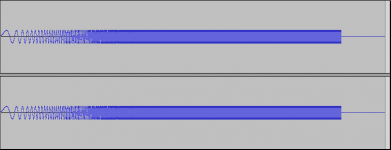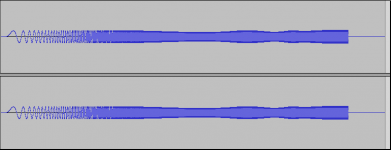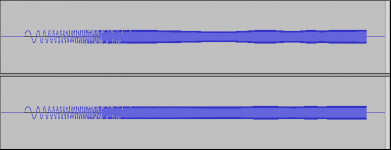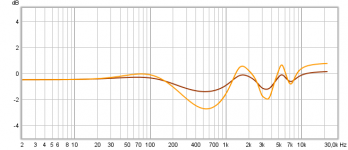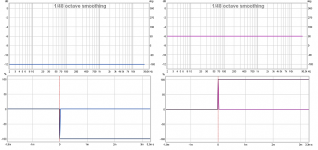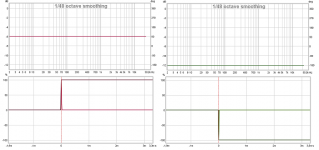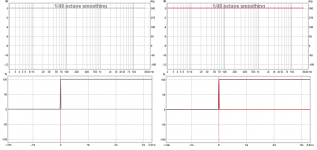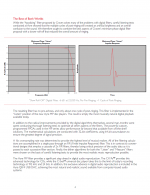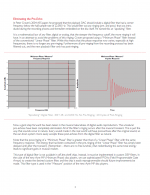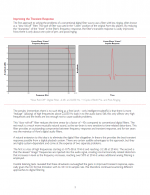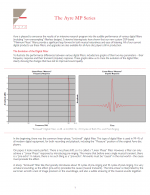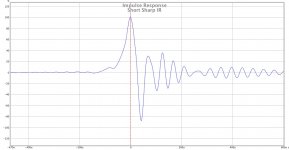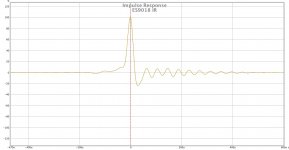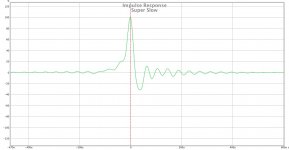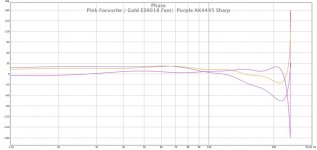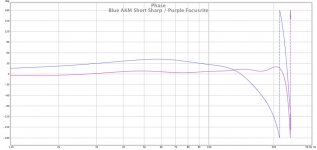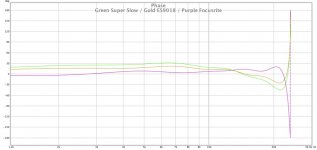Hi fluid,
Thanks for confirm that particular PEQ was right and guide me to run fabfilter trial, in lack of time right now have to wait debug more until later but so far can see using JRiver diskwriter that a exported 16bit REW measurement sweap looked into Audacity is not exactly same between my homebrew chain and fabfilter, well left-CH looks close but right-CH for my homebrew is different and my guess is process inside JRiver Encoding/Decoding could be the difference because linear phase filters I'm sure was set correct as numbers was listed into post 790. Reading a 16bit perfect impuls with REW that has been through JRiver without filters and with fabfilter looks as it should but I have to debug later why there is no IR in written file when convolution engine is used : )
From above work find Audacity views below for exported 16bit REW measurement sweap without filter, then comes fabfilter and last one is my homebrew filter.
Thanks for confirm that particular PEQ was right and guide me to run fabfilter trial, in lack of time right now have to wait debug more until later but so far can see using JRiver diskwriter that a exported 16bit REW measurement sweap looked into Audacity is not exactly same between my homebrew chain and fabfilter, well left-CH looks close but right-CH for my homebrew is different and my guess is process inside JRiver Encoding/Decoding could be the difference because linear phase filters I'm sure was set correct as numbers was listed into post 790. Reading a 16bit perfect impuls with REW that has been through JRiver without filters and with fabfilter looks as it should but I have to debug later why there is no IR in written file when convolution engine is used : )
From above work find Audacity views below for exported 16bit REW measurement sweap without filter, then comes fabfilter and last one is my homebrew filter.
Attachments
Last edited:
Looks like your 1st method was a good one, byrtt. Quite similar between FabFilter and homebrew!
Fluid, I understand my room and my setup are completely different. I will continue playing with your preset. I said I preferred without, but that doesn't mean I'll stop tweaking! This is DIY after all!
I have tested other EQ settings between linear and minimum phase, and I do hear the differences... actually, you can usually see the differences on the graph itself when looking at real world performance of minimum vs linear phase. The curves will have different shapes. Any video on the subject on Youtube will clearly show it.
I will continue to play with your preset, using the pan you suggested, and the different phase settings. I'll also tweak the M/S preset EQ to see if I can still have clear centre, and retain the extended stagehand life I have at the moment.
So, it's not over! I'm not quitting!
Fluid, I understand my room and my setup are completely different. I will continue playing with your preset. I said I preferred without, but that doesn't mean I'll stop tweaking! This is DIY after all!
I have tested other EQ settings between linear and minimum phase, and I do hear the differences... actually, you can usually see the differences on the graph itself when looking at real world performance of minimum vs linear phase. The curves will have different shapes. Any video on the subject on Youtube will clearly show it.
I will continue to play with your preset, using the pan you suggested, and the different phase settings. I'll also tweak the M/S preset EQ to see if I can still have clear centre, and retain the extended stagehand life I have at the moment.
So, it's not over! I'm not quitting!
Byrtt, there is a strange difference in how only one channel seems to have been processed with your Rephase version , I'll leave it up to you to figure out why as you have my settings to compare against directly on your own machine now 
When you get the chance I would be interested to know if you hear the same thing as before with FabFilter in the chain that you described earlier.
Perceval,
The change between linear and minimum phase was really to demonstrate that only changing the phase can be audible. I'm not sure about the videos you mention but if there are visible changes to the frequency response from only changing the phase then it isn't the test I am trying to show.
The phase change should be visible in a spectrogram or similar but not in a basic SPL graph.
When tweaking I would start with the relative levels and you may need to adjust the overall gain to compensate as the pan control is cut only which will make it quieter and that almost never sounds better.
I'll be interested to know if you make any changes that gets you an improvement
When you get the chance I would be interested to know if you hear the same thing as before with FabFilter in the chain that you described earlier.
Perceval,
The change between linear and minimum phase was really to demonstrate that only changing the phase can be audible. I'm not sure about the videos you mention but if there are visible changes to the frequency response from only changing the phase then it isn't the test I am trying to show.
The phase change should be visible in a spectrogram or similar but not in a basic SPL graph.
When tweaking I would start with the relative levels and you may need to adjust the overall gain to compensate as the pan control is cut only which will make it quieter and that almost never sounds better.
I'll be interested to know if you make any changes that gets you an improvement
I'm currently building a pair of Tritrix TLs from PE as I've pretty much abandoned the idea of building a line array when I found out how much work they are, not only to build but to tweak the sound with custom eq. Then room treatments, yada-yada...
I want something to plug into a basic two channel reciever and be done with,
Seems like a plan line arrays are not for casual builders
I would say that the level of listening measuring and tweaking is the same for any speaker. The level of reward goes hand in hand with the level of effort.
Building a kit and plonking it in a room will get you sound and maybe even good or great sound. But if you take the time and effort to measure, listen and tweak accordingly you will be rewarded for it.
There is a lot to be said for wesayso's philosophy or making the speaker you have better and more to your liking rather than building another one in the hope it will sound better. Assuming you have a speaker worth persisting with of course
You got yourself mixed up about the Mid Side thing it seems, no harm done, I had to chuckle reading that description from the builder, form over function has won out there, but enough from me as it has no relevance to this thread
Reading a 16bit perfect impuls with REW that has been through JRiver without filters and with fabfilter looks as it should but I have to debug later why there is no IR in written file when convolution engine is used : )
The IR you play trough JRiver and record, open it in an audio program and ad a second of silence to the start and end and try again. Convolution might move it out of the recorded window.
Looks like your 1st method was a good one, byrtt. Quite similar between FabFilter and homebrew!
Fluid, I understand my room and my setup are completely different. I will continue playing with your preset. I said I preferred without, but that doesn't mean I'll stop tweaking! This is DIY after all!
I have tested other EQ settings between linear and minimum phase, and I do hear the differences... actually, you can usually see the differences on the graph itself when looking at real world performance of minimum vs linear phase. The curves will have different shapes. Any video on the subject on Youtube will clearly show it.
I will continue to play with your preset, using the pan you suggested, and the different phase settings. I'll also tweak the M/S preset EQ to see if I can still have clear centre, and retain the extended stagehand life I have at the moment.
So, it's not over! I'm not quitting!
Strange, as the side info (responsible for the room queues) is not changed in this processing. Did you start with a straightened or corrected IR?
You might want to experiment with a reversed filter. Where the mid part stays linear and the sides get treated. Or maybe even out the differences between mid and side. As long as the relations in level between mid and side stay. Do play with bringing up the level/gain of the sides to + 0.5 dB.
I think it was a measurement sweep he played rather than a Dirac Pulse, without the reverse filter the IR doesn't get recovered from the sweep when done that way like it does in REW.The IR you play trough JRiver and record, open it in an audio program and ad a second of silence to the start and end and try again. Convolution might move it out of the recorded window.
Thanks tip wesayso, i tried different time frame added but it only adds grass which actually is different because without there is no IR inside written disk-file, case is only for diskwriter combined convolution engine, when using IIR filter containers or fabfilter combined diskwriter works fine, will revert to god old loopback of soundcards digital I/O and use JRiver WDM-driver in loop.
How irritating !!! to get a break will go out eating for a wile and come back ...
BTW what you fluid/wesayso call a Dirac pulse is that the same as a perfect syntetic IR created in Rephase ?
How irritating !!! to get a break will go out eating for a wile and come back ...
BTW what you fluid/wesayso call a Dirac pulse is that the same as a perfect syntetic IR created in Rephase ?
Last edited:
Yes, a Dirac pulse is a perfect IR as created in RePhase. I've had it happen to me, the case you describe here. Never did find out why. I can run them now, including the whole chain and even the convolver, but there have been glitches like this for me too. Very frustrating...
Edit: hope you get a good meal!
Edit: hope you get a good meal!
Last edited:
Think its complicated to figure out how the M/S en/decoding really works at least for me today 
Look brown curve here its fluids fabfilter benchmarked for one channel and the other channel looks exactly same, sum of EQ correction looks about end up half of real EQ correction numbers set in filter seen by orange curve:
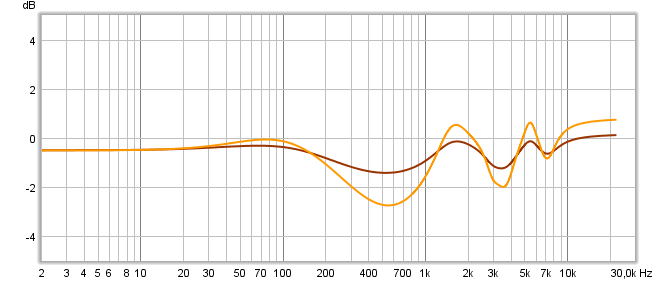
Had also some fun Benchmark JRivers M/S en/decoding filters.
Encoding L_CH -12dB plus phase inverts and Encoding for R_CH -6dB:
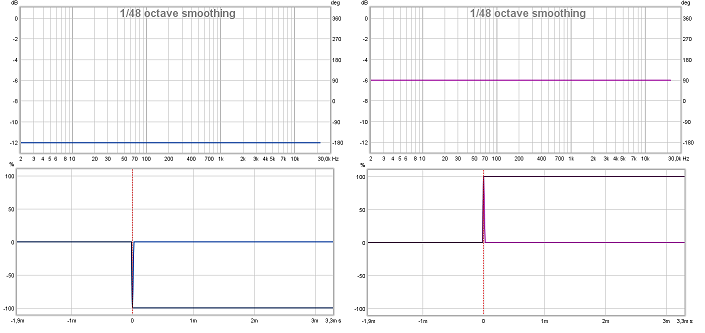
Decoding L_CH -6dB and Decoding R_CH -12dB plus phase inverts:
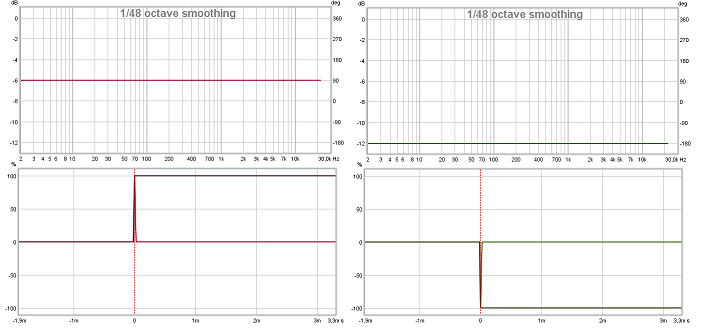
SUM of chained JRiver M/S en/decoding L_CH / R_CH:
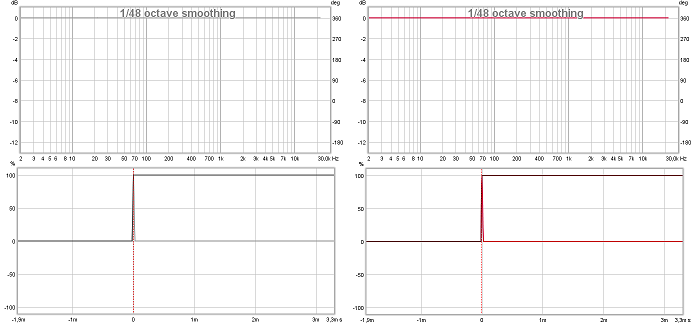
fluid,
Listened my homebrew verse yours and difference is not big but in homebrew is bit flawed when benchmarked had some more time listening to yours and overall its not best for this stereo signal feeded mono speaker but also must say its not a disaster when enabled. Sense it diffuse attack side for fast transients such as snare drum hits plus string attacks and also for more seldom real sounding symbols that had survived mix process not to be too washed out there already. Shifting filter from linear to minimum phase helps about the diffuse outcome, but still prefere sound as speaker is now but as said before when down the road system gets stereo and HRTF problems will arrive its very interesting subject to repeat.
wesayso,
Thanks hints and yes got a good meal down town, even it ended be pizza it was over average in it was enjoyed never boxed at the restaurant
Pano,
Talking small full rangers, remember try stay free from the needle and the damage it can do
Look brown curve here its fluids fabfilter benchmarked for one channel and the other channel looks exactly same, sum of EQ correction looks about end up half of real EQ correction numbers set in filter seen by orange curve:
Had also some fun Benchmark JRivers M/S en/decoding filters.
Encoding L_CH -12dB plus phase inverts and Encoding for R_CH -6dB:
Decoding L_CH -6dB and Decoding R_CH -12dB plus phase inverts:
SUM of chained JRiver M/S en/decoding L_CH / R_CH:
fluid,
Listened my homebrew verse yours and difference is not big but in homebrew is bit flawed when benchmarked had some more time listening to yours and overall its not best for this stereo signal feeded mono speaker but also must say its not a disaster when enabled. Sense it diffuse attack side for fast transients such as snare drum hits plus string attacks and also for more seldom real sounding symbols that had survived mix process not to be too washed out there already. Shifting filter from linear to minimum phase helps about the diffuse outcome, but still prefere sound as speaker is now but as said before when down the road system gets stereo and HRTF problems will arrive its very interesting subject to repeat.
wesayso,
Thanks hints and yes got a good meal down town, even it ended be pizza it was over average in it was enjoyed never boxed at the restaurant
Pano,
Talking small full rangers, remember try stay free from the needle and the damage it can do
Attachments
Looks like your filter was about double from that graph.
I'm not sure I understand the other graphs, are you trying to show that a pulse that is different in phase and level in either channel comes out the same when encoded and then decoded by the Jriver Mid Side process?
i.e. The Jriver Mid Side is working as it should and not doing anything to the signal?
It's no surprise really that it doesn't improve the sound for you but your descriptions are interesting I shall have to listen for that. Interesting that you found minimum phase to be better as it destroys the effect entirely for me. Thanks for taking the time.
Did you try to alter the relative level of Mid side with the pan control in FabFilter to see what effect that had?
Try those drum samples I sent you before, the dry studio at 6 feet is about as close to an unmolested drum kit recording as you will find. To me it sounds as close to a real kit in a room as I have heard. If you don't have them I can send the link again.
I'm not sure I understand the other graphs, are you trying to show that a pulse that is different in phase and level in either channel comes out the same when encoded and then decoded by the Jriver Mid Side process?
i.e. The Jriver Mid Side is working as it should and not doing anything to the signal?
It's no surprise really that it doesn't improve the sound for you but your descriptions are interesting I shall have to listen for that. Interesting that you found minimum phase to be better as it destroys the effect entirely for me. Thanks for taking the time.
Did you try to alter the relative level of Mid side with the pan control in FabFilter to see what effect that had?
Try those drum samples I sent you before, the dry studio at 6 feet is about as close to an unmolested drum kit recording as you will find. To me it sounds as close to a real kit in a room as I have heard. If you don't have them I can send the link again.
Orange is actual my convolution filter benchmarked but its set as in post 790 and actual fabfilter is set same but outcome when benchmarked is only in half, as example numbers for cut filter at 600Hz is -3dB which is same as orange where brown fabfilter is in half. Must be the complicated matrix of L_CH and R_CH from encoding to decoding that make it sum that way, and over my head to figure that out : )
Yeah at least it looks signal come harmless thru Jriver M/S en/decoding, what happens inside guess is supposed to be following schemes explained from gearslutz:
ENCODING: The left and right channels of a stereo recording are encoded to Mid and Side.
M = L + R
S = L - R
DECODING
LEFT = M + S = (L + R) + (L - R) = 2L
RIGHT = M - S = (L + R) - (L + R) = 2R
Agree its interesting share what it do for our particular diffrent systems including what perceval thought for his OB setup.
Will try adjust pan control tommorow and should it change anything will post about it.
Agree that dry studio drum track at 6 feet is excellent realistic, not to talk about listening the 3 feet one where i worry about get fingers in between hi-hat hardware being so close have just tested drum track with fabfilter and result is same as reported for other sessions.
have just tested drum track with fabfilter and result is same as reported for other sessions.
Yeah at least it looks signal come harmless thru Jriver M/S en/decoding, what happens inside guess is supposed to be following schemes explained from gearslutz:
ENCODING: The left and right channels of a stereo recording are encoded to Mid and Side.
M = L + R
S = L - R
DECODING
LEFT = M + S = (L + R) + (L - R) = 2L
RIGHT = M - S = (L + R) - (L + R) = 2R
Agree its interesting share what it do for our particular diffrent systems including what perceval thought for his OB setup.
Will try adjust pan control tommorow and should it change anything will post about it.
Agree that dry studio drum track at 6 feet is excellent realistic, not to talk about listening the 3 feet one where i worry about get fingers in between hi-hat hardware being so close
Chain can be seen in first picture below and hope i did it right in expect that after encoding filter Mid-CH is now right-CH revealed by "Analyzer" show right-CH to be the loudest, so Side must be left-CH.
Could this be where the problem is as all the other plugins I have looked at store the mid in the left channel and side in the right.
If you were to reverse the channels of your homebrew EQ I wonder if it comes out correctly, or maybe just completely stuffed up
I think the 3 feet is in front of the kit (probably a stereo mic technique of some sort) so no chance of hi-hat finger grabs for the engineer at least
Good suggestion there, actual i tried edit config file so the left and right IR-wav file it point to was switched around but will try again later because must admit sometimes its easy in heat of the moment to make some small user mistakes here and there and why it often is important and a help to benchmark system and filters afterwards before judging corrected sound output full of mistakes  .
.
Yesterday I put my dual AK4495 DAC into the system to listen to that. It has quite a number of different filters and the differences in the sound of them are more noticeable when used with the arrays.
I made myself a little audio "dizzy" switching between them
I couldn't decide which I preferred. If I had to listen now with only one I would probably choose the short delay sharp filter, which is minimum phase. The linear phase sharp filter was a little too aggressive. Most of the slow roll off filters sound quite dull with a 44K sampling rate. There was something quite enticing about the Super Slow Roll off filter as it made the sound stage widen and vocals were good but it suffers from rolling off too early. Surprisingly it did not sound as rolled off even though it has the most when measured, odd. I might see if I can tweak the target to take account of the rolloff and get it back to closer to what I have been listening to with the sharp filters. It might then become interesting.
It became even harder to decide when I switched the DRC filter to minimum phase, that the seemed to favour different filters.
For now the 9018 DAC or the Focusrite will go back in until I have the other DRC filter to try.
I made myself a little audio "dizzy" switching between them

I couldn't decide which I preferred. If I had to listen now with only one I would probably choose the short delay sharp filter, which is minimum phase. The linear phase sharp filter was a little too aggressive. Most of the slow roll off filters sound quite dull with a 44K sampling rate. There was something quite enticing about the Super Slow Roll off filter as it made the sound stage widen and vocals were good but it suffers from rolling off too early. Surprisingly it did not sound as rolled off even though it has the most when measured, odd. I might see if I can tweak the target to take account of the rolloff and get it back to closer to what I have been listening to with the sharp filters. It might then become interesting.
It became even harder to decide when I switched the DRC filter to minimum phase, that the seemed to favour different filters.

For now the 9018 DAC or the Focusrite will go back in until I have the other DRC filter to try.
Hi fluid,
Think it could make sense you would choose the short sharp filter which is minimum phase, cause is after have bench I/O on UMC204HD at 44,1kHz which has very same replica IR to yours Focusrite up against I/O another soundcards I/O with nearly zero ringing, result is UMC204HD have for input sharp linear phase pre/post ringing and for output it has minimum phase sharp wild post ringing. Over some headphone thread i find a paper form DAC manufacture and attached below and it makes sense input is filtered as page 1 and output is filtered as page 3. When we then correct our speaker system think it also makes sense that any unit inside chain we correct more or less so that you choose the sharp filter makes sense because Focusrite has such a one on its output.
These filter subjects in my eyes are irritating and looks a modern field steered by competition and capitalism, where in old days probably industry would have started out make some standard filters for the various sample rates so recording and playback for these filters would not be the difference we hear from various products but more what their silicon performance can reach.
Think it could make sense you would choose the short sharp filter which is minimum phase, cause is after have bench I/O on UMC204HD at 44,1kHz which has very same replica IR to yours Focusrite up against I/O another soundcards I/O with nearly zero ringing, result is UMC204HD have for input sharp linear phase pre/post ringing and for output it has minimum phase sharp wild post ringing. Over some headphone thread i find a paper form DAC manufacture and attached below and it makes sense input is filtered as page 1 and output is filtered as page 3. When we then correct our speaker system think it also makes sense that any unit inside chain we correct more or less so that you choose the sharp filter makes sense because Focusrite has such a one on its output.
These filter subjects in my eyes are irritating and looks a modern field steered by competition and capitalism, where in old days probably industry would have started out make some standard filters for the various sample rates so recording and playback for these filters would not be the difference we hear from various products but more what their silicon performance can reach.
Attachments
Last edited:
...My OB speakers are insane at creating the ambiance of the room where the recording was made. I can hear if a small studio was used, or a bigger one, just by listening to the reflections in the recording. I can "hear" the room where the microphone was. When a recording was made in a church, I'm in that church when I listen to it...
First has to say thanks sharing experience perceval its very interesting also to hear about OB.
Then comes the question why can this at all happen ??? what i mean here is if i listen in headphones even some new one i got where i have their non ideal curve on paper and corrected it to HARMAN-target curve for headphones which improve their sound to excellent i can't hear recording room/environment very well, sound is excellent balanced and pleasing but not really into recording room/environment, same is situation when positioned at same spot where microphone sat correcting speaker. But out at listening distance 2-4 meters there's a sense of getting lets say about 15-30% into recording room/environment, isn't this strange experience and should have been the other way around.
From a post in the Beyond the Ariel thread, I'm posting some details of the Mid Side EQ than I have been using. Wesayso has posted the specifics before and these are the settings he used.
I concur with wesayso that the EQ needs to be linear phase to sound "right". And the difference between linear and minimum phase EQ is not subtle in this application.
Mid Channel
100Hz Q 0.5 Gain 0.5
600Hz Q 0.5 Gain -3.0
1550Hz Q 1.5 Gain 2.0
3000Hz Q 3.5 Gain -1.0
3700Hz Q 2.7 Gain -2.0
5500Hz Q 4.0 Gain 1.0
7200Hz Q 3.0 Gain -1.5
High Shelf 2470Hz Q 0.5 Gain 0.8
Side Channel
Low Shelf 80Hz Q 0.70 Gain -0,5
This is what it looks like in the plugin
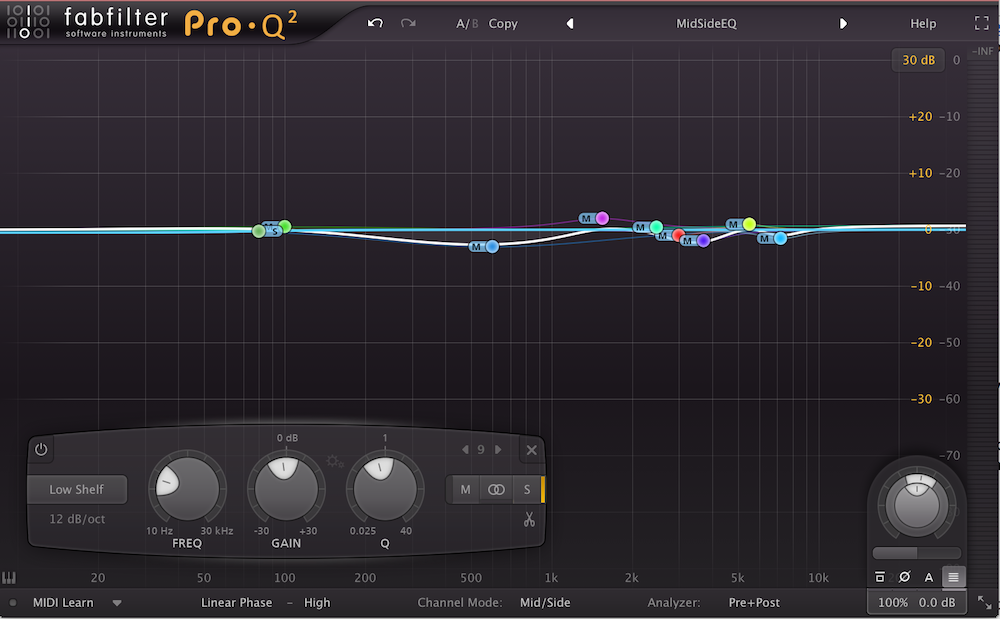
Wesayso boosts the sides by 0.5dB, I can't make up my mind but I have settled for cutting the sides by 1dB for now.
The more the sides are boosted the wider the stage becomes, I find that a bit weird and make it more mono by cutting the sides a little. That is the part that can be a bit track dependent as to the setting I prefer more.
There are a few plugins that can do this sort of EQ.
I am using FabFilter in MidSide mode and anyone that has that plugin can PM me to get a preset to save themselves the bother of inputing the EQ parameters.
IIEQPro can do it and Voxengo Ozone. Equilibre is free but only has 4 bands of Parametric EQ which isn't enough for all those listed above.
Voxengo MSED can do the encoding and decoding but would need to be used in a host program that can chain plugins.
Metaplugin can be used in Jriver to allow multiple plugins to be routed any which way but is not free but does include a mid side plugin.
If there is any interest I can try and make an impulse in Jriver that could be used in a convolution plugin or try and make a comparison track for people to test for themselves if they don't have the correct plugins.
Thanks fluid for posting the EQ. I presume the mid = L+R and side = L or R. Is that correct? I'll give it a try and report back. What method do you suggest using in combination with JRiver. Note that I already use the convolution engine and both parametric equalizers within JRiver for my current configuration.
Hi fluid,
Think it could make sense you would choose the short sharp filter which is minimum phase, cause is after have bench I/O on UMC204HD at 44,1kHz which has very same replica IR to yours Focusrite
Could be, although the Short Sharp has considerably more post ringing and is quite 'wild' as an Impulse response
The Super Slow Filter and the Sabre Fast Filter are somewhat similar overall and the most well behaved in the impulse response.
There are some phase differences
The minimum phase filter having the most obvious change
The Super Slow being the closest in shape to the Sabre
As far as I remember the Focusrite sounded a little better than the Sabre but it is hard to know if that was familiarity or because it had been "corrected" as it was in the loop when the measurements were taken.
I have tried before to divide out the signature of the Focusrite from the measurements to use the correction with other DAC's and overall it was not successful. There was either no real change or it sounded a bit weird on some vocals. The only thing it was useful for was when I used it to generate the measurement I based a rephase tweak on, that was only below 100Hz and got the generated minimum phase to line up better below 20Hz. It wasn't the only thing I changed so hard to say if it made any real difference other than making the graph look better.
Maybe at some point I can take some measurements with different devices in the chain and generate corrections based on those to see if there is any change. I am getting a bit tired of "tweaking" for now and also getting short of time.
The effort I have put in has got me some pretty good sound so I can enjoy that for now
Attachments
- Home
- Loudspeakers
- Full Range
- Full Range TC9 Line Array CNC Cabinet
